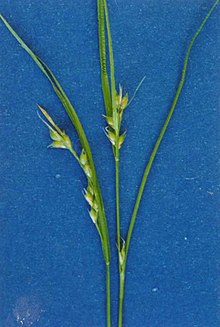Carex rossii
| Carex rossii | |
|---|---|
 |
|
| Scientific classification | |
| Kingdom: | Plantae |
| (unranked): | Angiosperms |
| (unranked): | Monocots |
| (unranked): | Commelinids |
| Order: | Poales |
| Family: | Cyperaceae |
| Genus: | Carex |
| Species: | C. rossii |
| Binomial name | |
|
Carex rossii Boott |
|
| Synonyms | |
|
|
Carex rossii, commonly known as Ross's sedge, is a hardy, monoecious species of sedge that is often a pioneer species in areas with little or no established vegetation, or in places where disturbance has occurred. It flowers in May and June.
Carex rossii produces a dense clump, or solid mat of slender stems up to about 40 centimetres (16 in) from a shallow network of rhizomes. The pale to dark green leaves are usually longer than the stems. The inflorescences contain one or more staminate flower spikes above more rounded pistillate spikes. The fruit is three-sided, and covered in a greenish or brownish perigynium.
Carex rossii is native to, and sometimes abundant in, Alaska and subarctic Canada (Nunavut, Northwest Territories, and Yukon Territory); western Canada (Alberta, British Columbia, Manitoba, and Saskatchewan); and the contiguous U.S. (Arizona, California, Colorado, the Dakotas, Idaho, Minnesota, Montana, Nevada, New Mexico, Oregon, Utah, Washington, and Wyoming.) It is found only sporadically in Ontario, Michigan, and Nebraska.
...
Wikipedia
